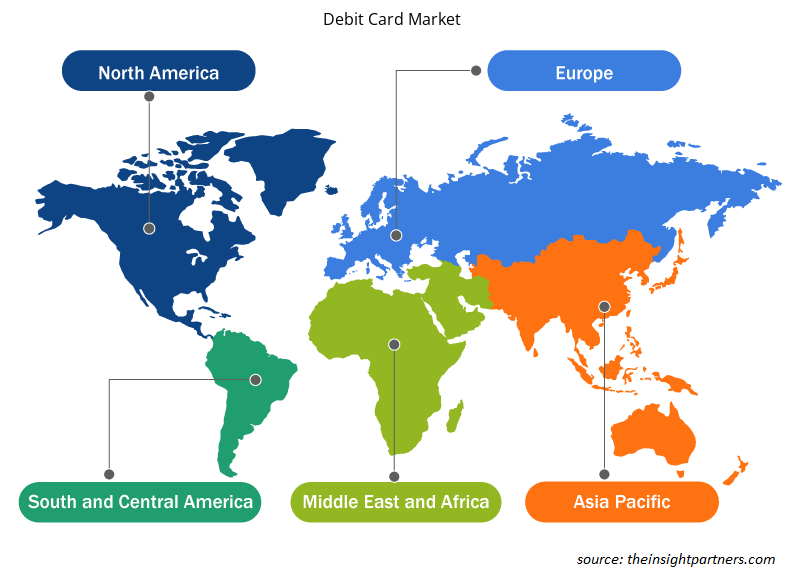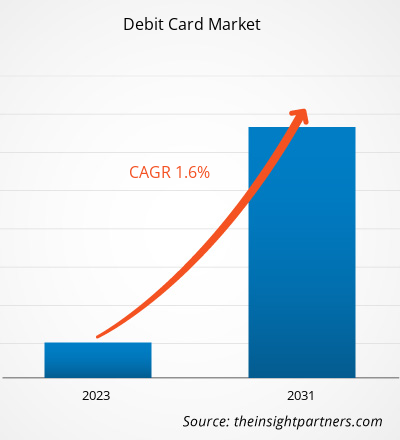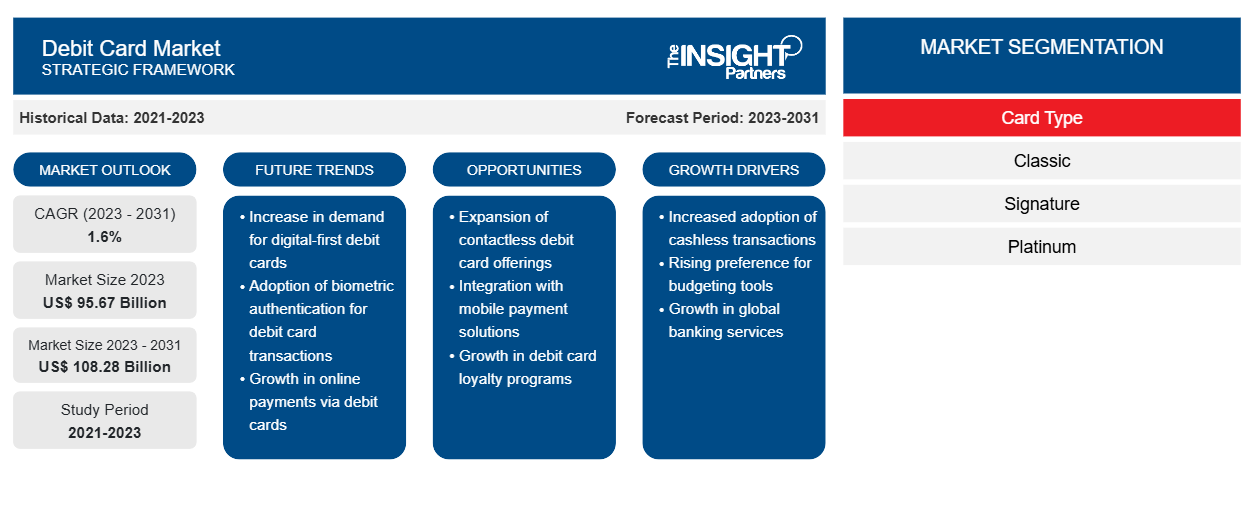Es wird erwartet, dass der Umfang von 95,67 Milliarden US-Dollar im Jahr 2023 auf 108,28 Milliarden US-Dollar im Jahr 2031 ansteigt; von 2023 bis 2031 wird mit einer durchschnittlichen jährlichen Wachstumsrate von 1,6 % gerechnet.
Debitkarten-Marktanalyse
Die Prognose für den Debitkartenmarkt wird auf der Grundlage verschiedener sekundärer und primärer Forschungsergebnisse geschätzt, wie z. B. wichtiger Unternehmensveröffentlichungen, Verbandsdaten und Datenbanken. Das Wachstum des Debitkartenmarktes ist auf die zunehmende Zugänglichkeit und Bequemlichkeit, einen Rückgang der Abhängigkeit von Bargeld, eine höhere Verbreitung von Bankkonten, verbesserte Sicherheitsfunktionen und einen verbesserten Betrugsschutz sowie die Einbindung in digitale Banksysteme zurückzuführen .
Das prognostizierte Wachstum im Prognosezeitraum ist auf die zunehmende Einführung kontaktloser Zahlungen, Initiativen zur finanziellen Inklusion, die Ausweitung staatlich geführter bargeldloser Initiativen, die Integration von Funktionen zur Verwaltung persönlicher Finanzen sowie das Wachstum von Online-Ausgaben und E-Commerce zurückzuführen. Zu den wichtigsten Trends auf dem Debitkartenmarkt, die im Prognosezeitraum erwartet werden, gehören die Einbeziehung digitaler Währungen, die Entwicklung maßgeschneiderter Budgetierungstools, die Anwendung verbesserter Maßnahmen zur Betrugsprävention, die Verschmelzung mit Open-Banking-Systemen sowie die Bildung von Fusionen und Partnerschaften mit Fintech-Unternehmen.
Debitkarte
Branchenüberblick
- Das Wachstum des Debitkartenmarktes wird durch eine Verringerung der Verwendung von Bargeld aufgrund zahlreicher Faktoren gefördert. Regierungen und Institutionen weltweit arbeiten aktiv daran, Bargeldtransaktionen zu minimieren, und nennen dabei Vorteile wie Geldwäscherisiken und geringere Kriminalität, weniger Steuerhinterziehung und niedrigere Transaktionskosten für Unternehmen. So wies beispielsweise ein im Juni 2021 veröffentlichter Bericht der Financial Times auf eine Reduzierung der Barzahlungen um 35,0 % hin und unterstreicht damit den aktuellen Trend zu digitalen Zahlungen, der den Debitkartenmarkt voraussichtlich ankurbeln wird.
- Die großen Akteure auf dem Debitkartenmarkt erfinden neue Produkte, indem sie aufkleberbasierte Debitkartenprodukte einführen, um ihren Kundenstamm zu vergrößern und ihren Umsatz zu steigern. Diese kontaktlosen Debitkarten haben die Form kleiner Aufkleber, die auf zahlreichen Geräten wie Smartwatches, Notebooks und Mobiltelefonen angebracht werden können. So kündigte das in Indien ansässige Finanzinstitut IDFC im November 2022 in Zusammenarbeit mit der National Payments Corporation of India (NPCI) die Einführung der ersten aufkleberbasierten Debitkarte Indiens, FIRSTAP, an. Diese kontaktlose Technologie soll reibungslose digitale Transaktionen ermöglichen und die Verantwortung der Branche für kundenorientierte Lösungen unter Beweis stellen.
Passen Sie diesen Bericht Ihren Anforderungen an
Sie erhalten kostenlos individuelle Anpassungen an jedem Bericht, einschließlich Teilen dieses Berichts oder einer Analyse auf Länderebene, eines Excel-Datenpakets sowie tolle Angebote und Rabatte für Start-ups und Universitäten.
-
Holen Sie sich die wichtigsten Markttrends aus diesem Bericht.Dieses KOSTENLOSE Beispiel umfasst eine Datenanalyse von Markttrends bis hin zu Schätzungen und Prognosen.
Treiber des Debitkartenmarktes
Wachsende E-Commerce-Branche treibt Marktwachstum voran
- Mit der zunehmenden Verbreitung des Online-Shoppings entscheiden sich Kunden für Debitkarten, um reibungslose und sichere Transaktionen zu ermöglichen. Die Einbindung von Debitkarten in Online-Zahlungsgateways hat das Wachstum des E-Commerce weiter angekurbelt , insbesondere in der Zeit nach Covid, in der der Trend zum Online-Shopping zugenommen hat. Bemerkenswerterweise erreichten die Online-Einzelhandelsumsätze laut der Handels- und Entwicklungskonferenz der Vereinten Nationen (UNCTD) im April 2022 im Jahr 2021 2,9 Billionen US-Dollar, wobei die USA und China den größten Anteil daran hatten. Somit fördert die Zunahme der E-Commerce-Aktivitäten weiterhin das Wachstum des Debitkartenmarktes.
Debitkarte
Marktbericht-Segmentierungsanalyse
- Basierend auf dem Kartentyp ist der Debitkartenmarkt in Classic, Signature, Platinum, Gold und andere unterteilt. Das klassische Segment hatte im Jahr 2023 einen bedeutenden Marktanteil bei Debitkarten.
- Eine klassische Debitkarte ermöglicht schnelles und einfaches Bezahlen mit entsprechenden Vorteilen der Bank. Verschiedene Anbieter wie Rupay, Mastercard, Visa und andere bieten diese Art von Debitkarten an.
Debitkarte
Marktregionale Analyse
Der Umfang des Debitkartenmarktberichts ist hauptsächlich in fünf Regionen unterteilt: Nordamerika, Europa, Asien-Pazifik, Naher Osten und Afrika sowie Südamerika. Nordamerika verzeichnet ein schnelles Wachstum und wird voraussichtlich im Jahr 2022 einen nennenswerten Marktanteil bei Debitkarten halten. Dieses Wachstum ist auf die Präsenz wichtiger Akteure in der Region zurückzuführen. Darüber hinaus wird erwartet, dass die Region Asien-Pazifik im Prognosezeitraum mit einer erheblichen durchschnittlichen jährlichen Wachstumsrate (CAGR) wächst.
Debitkarte
Regionale Einblicke in den Debitkartenmarkt
Die regionalen Trends und Faktoren, die den Debitkartenmarkt im Prognosezeitraum beeinflussen, wurden von den Analysten von Insight Partners ausführlich erläutert. In diesem Abschnitt werden auch die Marktsegmente und die Geografie des Debitkartenmarkts in Nordamerika, Europa, im asiatisch-pazifischen Raum, im Nahen Osten und Afrika sowie in Süd- und Mittelamerika erörtert.

- Holen Sie sich regionale Daten zum Debitkartenmarkt
Umfang des Debitkartenmarktberichts
| Berichtsattribut | Details |
|---|---|
| Marktgröße im Jahr 2023 | 95,67 Milliarden US-Dollar |
| Marktgröße bis 2031 | 108,28 Milliarden US-Dollar |
| Globale CAGR (2023 - 2031) | 1,6 % |
| Historische Daten | 2021-2023 |
| Prognosezeitraum | 2023–2031 |
| Abgedeckte Segmente |
Nach Kartentyp
|
| Abgedeckte Regionen und Länder |
Nordamerika
|
| Marktführer und wichtige Unternehmensprofile |
|
Marktdichte von Debitkarten: Auswirkungen auf die Geschäftsdynamik
Der Debitkartenmarkt wächst rasant, angetrieben durch die steigende Nachfrage der Endnutzer aufgrund von Faktoren wie sich entwickelnden Verbraucherpräferenzen, technologischen Fortschritten und einem größeren Bewusstsein für die Vorteile des Produkts. Mit steigender Nachfrage erweitern Unternehmen ihr Angebot, entwickeln Innovationen, um die Bedürfnisse der Verbraucher zu erfüllen, und nutzen neue Trends, was das Marktwachstum weiter ankurbelt.
Die Marktteilnehmerdichte bezieht sich auf die Verteilung der Firmen oder Unternehmen, die in einem bestimmten Markt oder einer bestimmten Branche tätig sind. Sie gibt an, wie viele Wettbewerber (Marktteilnehmer) in einem bestimmten Marktraum im Verhältnis zu seiner Größe oder seinem gesamten Marktwert präsent sind.
Die wichtigsten auf dem Debitkartenmarkt tätigen Unternehmen sind:
- American Express-Unternehmen
- Bank of America Corporation
- Toronto-Dominion Bank
- Banco Santander SA
- Citigroup Inc.
Haftungsausschluss : Die oben aufgeführten Unternehmen sind nicht in einer bestimmten Reihenfolge aufgeführt.

- Überblick über die wichtigsten Akteure auf dem Debitkartenmarkt
Die „Debitkarten-Marktanalyse“wurde basierend auf Kartentyp und Geografie durchgeführt. In Bezug auf den Kartentyp ist der Markt in Signatur, Platin, Gold und andere unterteilt. Basierend auf der Geografie ist der Markt in Nordamerika, Europa, Asien-Pazifik, den Nahen Osten und Afrika sowie Südamerika unterteilt.
Debitkarte
Marktnachrichten und aktuelle Entwicklungen
Unternehmen verfolgen im Debitkartenmarkt anorganische und organische Strategien wie Fusionen und Übernahmen. Nachfolgend sind einige aktuelle Marktentwicklungen aufgeführt:
- Im September 2022 gab JP Morgan, eine multinationale Investmentbank mit Sitz in den USA, die Übernahme von Renovite Technologies bekannt, um ihr Ziel der Entwicklung einer Zahlungsabwicklungsplattform der nächsten Generation voranzutreiben. Renovite Technologies, ein in den USA ansässiger Anbieter von Zahlungslösungen, bringt Fachwissen mit, das mit JP Morgans Vision für verbesserte Zahlungsdienste übereinstimmt.
(Quelle: JP Morgan, Unternehmenswebsite)
Debitkarte
Marktberichtsabdeckung und Ergebnisse
Der Marktbericht „Debit Card Market Size and Forecast (2021–2031)“ bietet eine detaillierte Analyse des Marktes, die die folgenden Bereiche abdeckt:
- Marktgröße und -prognose auf globaler, regionaler und Länderebene für alle abgedeckten wichtigen Marktsegmente.
- Marktdynamik wie Treiber, Beschränkungen und wichtige Chancen.
- Wichtige Zukunftstrends.
- Detaillierte PEST- und SWOT-Analyse
- Globale und regionale Marktanalyse, die wichtige Markttrends, wichtige Akteure, Vorschriften und aktuelle Marktentwicklungen abdeckt.
- Branchenlandschaft und Wettbewerbsanalyse, einschließlich Marktkonzentration, Heatmap-Analyse, Schlüsselakteuren und aktuellen Entwicklungen.
- Detaillierte Firmenprofile.
- Historische Analyse (2 Jahre), Basisjahr, Prognose (7 Jahre) mit CAGR
- PEST- und SWOT-Analyse
- Marktgröße Wert/Volumen – Global, Regional, Land
- Branchen- und Wettbewerbslandschaft
- Excel-Datensatz
Aktuelle Berichte
Erfahrungsberichte
Grund zum Kauf
- Fundierte Entscheidungsfindung
- Marktdynamik verstehen
- Wettbewerbsanalyse
- Kundeneinblicke
- Marktprognosen
- Risikominimierung
- Strategische Planung
- Investitionsbegründung
- Identifizierung neuer Märkte
- Verbesserung von Marketingstrategien
- Steigerung der Betriebseffizienz
- Anpassung an regulatorische Trends























 Kostenlose Probe anfordern für - Debitkartenmarkt
Kostenlose Probe anfordern für - Debitkartenmarkt